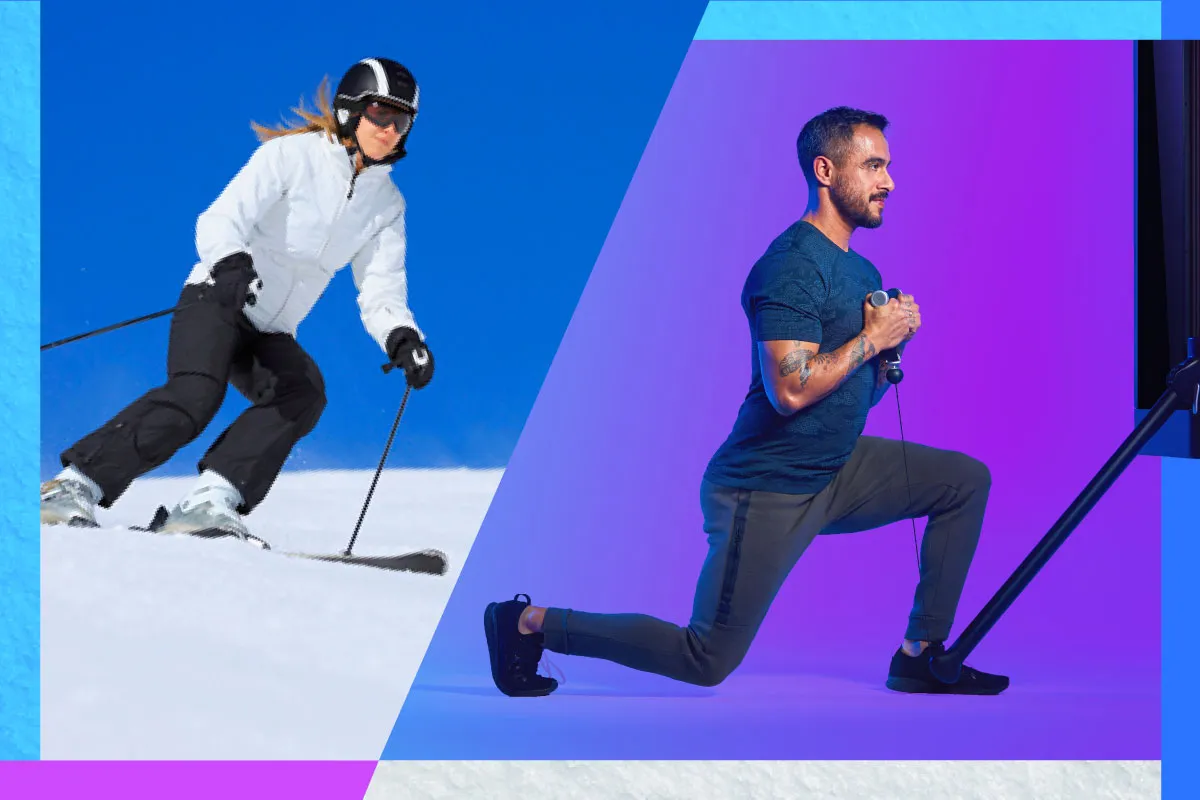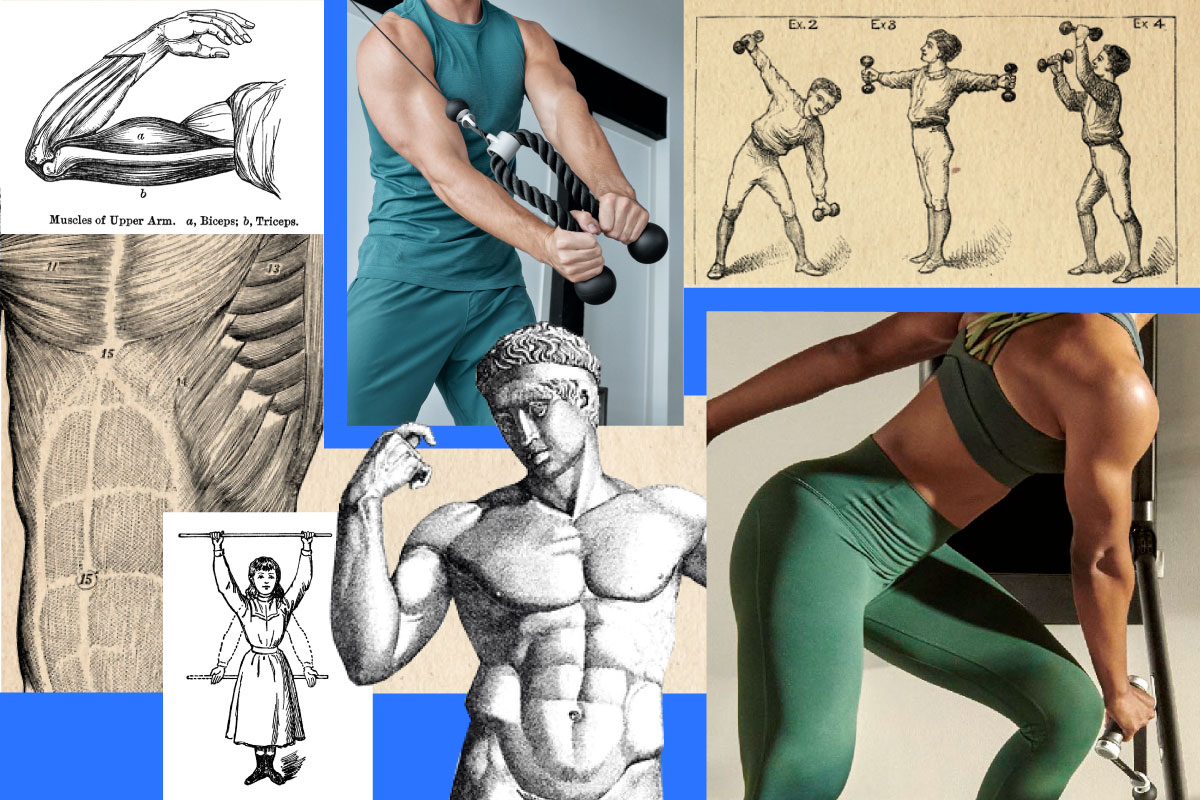Feeling inspired to hit the slopes? Follow these pro tips to build strength, improve stamina, and stay injury-free.

Ripping down the slopes on a ski day is thrilling. What’s less thrilling: Hobbling around the next day because you’re so sore. That’s why what you do off the mountain to prepare for epic runs is so important.
“Whether you’re an Olympic skier, a weekend warrior, or just on a ski trip, there’s something very specific about the muscle fatigue associated with skiing,” explains Troy Taylor, Senior Director of the Tonal Strength Institute and the former High Performance Director for U.S. Ski and Snowboard teams. “Resistance training on Tonal is a great opportunity to prepare your body for the demands of alpine skiing and make the most of your time on the slopes.”
By strength training regularly before you catch the first chair, you’ll build your stamina and strength for all-day ski adventures, reduce your risk of injury, and prevent soreness—all from the comfort of your own home. Here are six skiing tips from Taylor that can help you level up your game.

Build Lower-Body Strength to Ski Strong
Alpine skiing relies on deep knee flexion to maintain control and absorb bumps along the way. As you cruise down the mountain, your posterior chain lights up as eccentric forces challenge your glutes, hamstrings, and quadriceps. Building strength in these muscles can translate directly to your ski performance.
“On steeper or faster runs, your body is resisting gravity when you turn, and the strength in your posterior chain is really important,” explains Taylor. With Tonal’s dynamic weight modes you can overload the lower body safely using Spotter mode, which senses when you’re struggling and kicks in to lower the weight. That way, you can confidently challenge yourself with a heavier load.
“Building a solid foundation of general strength and strength endurance through squatting and deadlifting patterns is definitely the place to start” suggests Taylor. “And then progressing to sport-specific movements, like unilateral or single-leg work, balance, and dynamic stability. Turning on Eccentric mode on Tonal can help you overload the eccentric portion of the move, learn to fight fatigue setting in, and prepare you for the harder runs.”
Make Weight Shifts Easier With Unilateral Strength
As you shift your weight from one leg to the other at top speed, strength, balance, and mobility on each leg become increasingly important. This is where unilateral training comes in. Split squats, lunge variations, step-ups, and single-leg Romanian deadlifts are staples in many Tonal workouts.
“There are multiple phases of a ski turn including the initiation, turning, and completion phase before transitioning to the next one,” Taylor explains. “During the turning phase, your knee is in deep flexion and most of the force is ideally going through your outside ski. And so from a weight training perspective, we would really train for that position.”
Taylor suggests including variations of single-leg exercises that mimic the strength and mobility needed at the edge of the turn and performing them with full range of motion. This will translate to shifting your weight easily on the turns and moving with more power and efficiency.
To ensure you’re loading your exercises with the essential deep knee bend in skiing, the Form Feedback feature will tell you if you can get a deeper range of motion. Tonal’s Smart Handles also allow you to effortlessly switch from one exercise to another, adding resistance at the touch of a button without switching dumbbell sets and constantly racking and re-racking weights.

Develop Better Control With Core Stabilizers
Having a strong, stable core is essential to keep you balanced and upright. Every time you weave side-to-side on the descent, your body is resisting forces working against you on each turn.
“Skiing is very dynamic; the surface is constantly changing,” Taylor says. Strengthening the muscles surrounding your pelvis (think: abdominals, lower back muscles, glutes, hip flexors, abductors, and adductors) helps build the stable core needed to navigate the bumps and uneven terrain as you zip downhill. Core stabilization exercises are built into most workout programs on your Tonal, but you also have the option to tap into Pilates content to build more efficient, controlled movements.
Build Stamina For Fuller Ski Days
If you’re a speed demon on the slopes, you’re probably tapping into anaerobic power, an high intensity that relies on carbohydrates instead of oxygen to fuel your work. While this energy system is really useful for fast, explosive power, you can fatigue quickly and use up all of your carbohydrates stored in the body.
Training the anaerobic systems through resistance training helps lengthen the time you can spend at a high intensity so you can avoid feeling gassed halfway down the mountain. Total-body movements, like in Power HIIT classes, prepare your metabolic systems to produce explosive energy for fast runs.
See Tonal in Action
“Whether you’re an elite or recreational skier, any one run is quite anaerobic in nature because it’s relatively short,” notes Taylor. “Unless you’re going to the top of the Alps and skiing down to the base of the valley in one go, most of the runs that most of us take are maybe 60 seconds long.”
For a full day on the slopes, however, priming your aerobic system is essential so you don’t have to take breaks between runs or catch your breath halfway down the mountain. “We accumulate a lot of runs over a day,” Taylor adds. “Therefore, aerobic endurance becomes really important for recovery between runs.”
If you want to ski from the first chair to après-ski, your aerobic capacity may determine that. Your body is also more efficient with a strong aerobic base, using more fat for energy rather than burning through carbohydrate stores. Building in cardio, both on your trainer and off, will keep you moving on a long ski day. “It’s really about maximizing your ski trip, having the most enjoyable runs, and by the end of each chair lift, feeling recovered and ready to push again.”

Protect your joints and prevent injury
Skiing comes with injury risks but improving strength is one of the most effective measures you can take to protect yourself. “If you’ve been around a ski slope, chances are you’ll see someone on crutches,” says Taylor. “Sometimes accidents happen. If you hit some ice when you’re going down the slope 30, 40, 50 mph with a four- to six-foot ski, one-and-a-half-meter ski on your foot, there’s very little you can do to avoid injury.”
One-third of all reported injuries during skiing are knee-related. Anterior cruciate ligament (ACL) and medial collateral ligament (MCL) tears are the most common. But you’re especially susceptible to injury at the end of your runs when you’re tired. “Research shows that close to 50 percent of ski injuries in racing happened in the last 25 percent of the race, and I’m sure that more injuries happen in the afternoon than in the morning in recreational skiing,” Taylor says.
That’s where resistance training comes in. You can lower your risk by priming your body with lower-body strength and core stability so that fatigue doesn’t set in and you can maintain your technical competence, explains Taylor.
“Utilizing the real-time data that Tonal gives you, you can see your power output and range of motion on every rep—keeping that consistent through your sets can help ensure you’re getting the right muscle activation to prevent injury,” he adds. You’ll be on your way to après-ski without injury by putting the work in ahead of time.
Reduce soreness days later
Ideally, you leave the mountain injury-free, but you might still feel a little beat up later. Delayed onset muscle soreness (DOMS) can set in 12 to 24 hours after your ski session and peak at 24 to 72 hours.
Prep those muscles on Tonal with some overload work. Taylor calls this the “repeated-bout effect.” You train the muscles in a similar enough way to how they are activated when you’re skiing so that your body is used to that movement pattern, and it reduces DOMS. Try tapping into the benefits of digital weight for a smarter, faster, more challenging workout.



